Contents
Dermatitis is a skin disease caused by external or internal (physical, chemical, biological) agents, often on the background of hereditary predisposition and stress. Dermatitis is manifested by local and general reactions. Depending on the nature and severity of the pathogenesis, the disease is accompanied by a decrease in skin functions, a violation of the homeostasis of the body.
Dermatitis is a term that combines a wide variety of skin diseases into a common nosological group. In textbooks on medical dermatology, skin diseases are referred to as predominantly local (dermatitis) or systemic (toxidermia, dermatosis). However, there is almost always a correlation between local and general diseases.
Factors of pathogenic effects in dermatitis:
Stress. At the stage of depletion of adaptive reactions, stress can be the only factor against the background of unstable health (hereditary predisposition, weak immunity) or be combined with other factors of pathogenic influence;
Contact. Burn (thermal, chemical, solar, allergic), frostbite – all this provokes contact dermatitis;
Entry. The pathogen enters the blood through the digestive tract, respiratory system or parenterally (subcutaneously, intramuscularly, intravenously) – then atopic dermatitis develops.
Symptoms of dermatitis
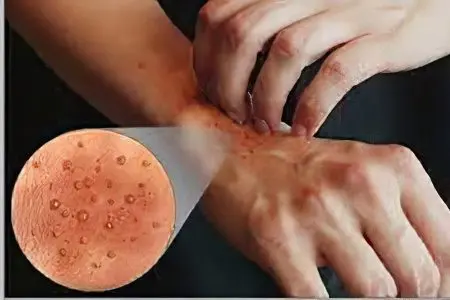
Dermatitis is closely associated with inflammatory and allergic reactions, occurs in acute and chronic forms, in some cases they are characterized by seasonal exacerbation and persistent course of the disease. In differential diagnosis, obligatory (large) and additional (small) symptoms are distinguished.
Mandatory symptoms characteristic of most dermatitis, regardless of the cause:
Sudden (prurigo). Its intensity depends on the strength of irritation of the skin nerve endings. The discrepancy between the strength of prurigo and skin manifestations (severe itching with minor rashes) is a sign of allergy in atopic dermatitis. With contact dermatitis, itching at the site of pathogen application is adequate to damage;
Redness (erythema). Erythema – increased blood supply to the dermal capillaries. In the acute form, redness with fuzzy edges and swelling is observed. For the chronic course of dermatitis, erythema is not required. When pressed, the area of hyperemic skin turns pale for a while. Erythema should not be confused with hemorrhage (bleeding under the skin). Hemorrhage is considered as a separate manifestation in skin pathologies – hemorrhagic diathesis;
Eruption (eczema). The morphology of the rash and its localization of eczema are typical for a particular dermatitis. The most common localization of rashes is moving parts of the body (skin over the joints), face, scalp, sides of the body, inguinal region;
Exudation. In acute forms of dermatitis, exudative inflammation with copious discharge is possible. In chronic forms – lichenification (thickening of skin areas with a rough pattern), cracks in the skin and excoriation (self-combing);
Peeling of the skin (desquamation). Pathological desquamation is caused by increased dryness (xerosis) of the skin with dehydration and insufficiency of the sebaceous glands. Desquamation and xerosis are noted in chronic dermatitis with allergic and inflammatory processes.
Additional symptoms are important in the differential diagnosis of specific dermatitis, are detected during a survey, examination, laboratory tests and functional tests.
Causes of dermatitis
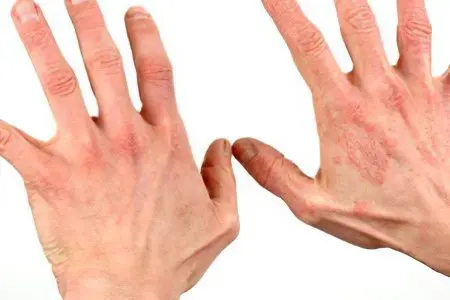
The main forms of inflammatory and allergic skin diseases, excluding occasional dermatitis, are the result of distant (genetic and acquired) and close (provoked) causes.
I. distant causes
Remote causes due to genetic and acquired individual predisposition to dermatitis:
Genetic (hereditary) predisposition to dermatitis. The causes and mechanism of inheritance of damaged genes are not fully understood. Dermatitis in newborns in 30-50% of cases is caused by allergies of one or both parents. Dermatitis in adults is implicitly correlated with the allergies of their parents, which can significantly complicate the search for causes and diagnosis;
Acquired predisposition to dermatitis. It has been established that 50-70% of persons who first fell ill with atopic dermatitis acquired sensitivity to dermatitis without the participation of genetic transmission. The parents of these people did not have allergies. Proven is the predisposition to dermatitis acquired during life against the background of inferior immunity. It has been observed that regular training of the immune system with weak antigens, for example, when communicating in small groups, stimulates the development of full-fledged immunity (not to be confused with infections);
Physical ill health, mental anxiety, unfavorable social and living conditions;
Re-illness with infectious, invasive, internal non-communicable diseases, especially in a chronic form.
II. close reasons
Close causes (trigger factors of dermatitis). When an organism from a relatively stable state under the influence of pathogenic factors becomes ill with dermatitis, the trigger mechanism of pathogenesis can be:
Stress. In the everyday sense, stress is associated with poor health. This is a common misconception. Stress is a complex protective and adaptive reaction involving hormones, which consists of several stages. At the first stage, under the influence of the adrenaline hormone, energy is released, and at the last stage, also under the influence of hormones (corticosteroids and others), the defenses are depleted and the immune system is suppressed. Stress is a provocateur of an imbalance of genetically determined and / or acquired predisposition to dermatitis and can be combined with other trigger factors;
Contact or other way of entering the blood of pathogenic substances (factors) and their further effect on the skin. Protein structures, substances of a chemical nature, physical factors (solar radiation, heat, frost) can be pathogens (allergens).
It has been established that dermatitis does not always develop, some people have individual sensitivity or resistance. Based on this, the factors (causes) of dermatitis are divided into obligate and optional.
Mandatory (obligatory) factors that trigger the mechanism of the pathogenesis of dermatitis in absolutely all persons exposed to adverse factors:
Strong allergens (contact and other effects);
Radiation (sun, quartz, radiation);
High temperature (over 600 FROM);
Low temperature or prolonged exposure to the skin;
Aggressive liquids (concentrated acids, alkalis).
Optional (selective) factors that trigger the pathogenesis of dermatitis and have a negative impact only on people with individual hypersensitivity:
Food, drugs, plant pollen, insect scales, animal hair;
Some contact allergens (detergents, cosmetics, insect bites);
Temperature of +4 0 C (this is the threshold temperature at which the pathogenesis of contact allergy to cold begins).
Determining the causes of the disease is a very important step for diagnosing dermatitis and prescribing adequate, effective treatment.
How to distinguish psoriasis from dermatitis?
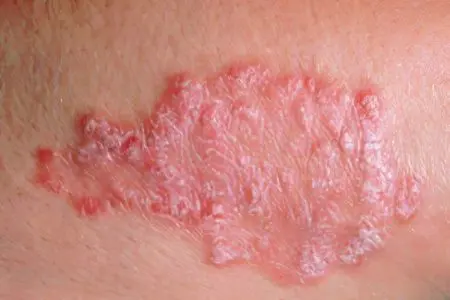
Psoriasis is a non-contagious autoimmune disease.
An external examination of a patient with psoriasis on the skin reveals:
Plaques of red and pink color with a white coating, usually located on the outside of the joints or on the head;
Itching, dryness and flaking of the skin.
In some cases, psoriasis also reveals:
Damage to nails and joints;
Damage to the skin and mucous membranes of the eyes.
The differential diagnosis of psoriasis is carried out using a dermatoscope (an optical device for examining the skin with multiple magnification). On the affected area, pathognomonic (leading) symptoms of psoriasis are found that are not found in other dermatitis, namely, peculiar papules and a symptom of “blood dew”.
Unique differences between psoriasis and dermatitis:
Papules in psoriasis consist of dead cells of the epidermis (areas of the skin on which the natural process of peeling and renewal is disrupted);
The symptom of “blood dew” is the result of an increase in capillary permeability and extravasation (going beyond the capillaries) of the liquid part of the blood.
Types of dermatitis:
Dermatitis has a complex classification – almost all dermatitis has several synonyms. The name is based on:
Localization of pathogenesis (contact, atopic);
The nature of the reactions (allergic, inflammatory, infectious, fungal);
The nature of the course of the disease (acute, chronic);
Name of primary (bullous, vesicular, etc.) or secondary (scaly, etc.) rashes;
The size of the rash (miliary, nummular, etc.);
Leading symptoms (dry, itchy, exudative, etc.);
The clinical manifestation of dermatitis, resembling any formation that does not have an etiological basis for this disease (lichen).
An exhaustive list of types of dermatitis can be found in the International Classification of Diseases (ICD). Below is a description of the general symptoms of dermatitis without differentiation.
Dry dermatitis
It manifests itself in the cold period, usually in the elderly and people with dry skin, predisposed to allergies. The disease in the period of exacerbation significantly reduces the quality of life. In advanced cases, it is a provocateur of other forms of dermatitis, complicates the diseases in the patient’s history (venous insufficiency, swelling of the lower extremities, and others).
Causes of dry dermatitis:
Cold and dry weather, dry indoor air;
Organic and functional diseases;
hereditary factor;
psychosomatic factor.
Dry dermatitis has a characteristic localization on the feet, rarely occurs in other areas of the skin. The disease is characterized by:
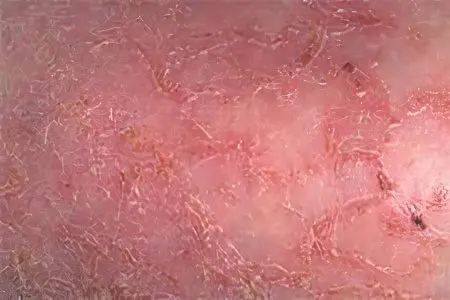
Chronic (sluggish) course and pronounced seasonality;
Xerosis – increased dryness of the skin (the result of insufficient functioning of the sebaceous and sweat glands), cracking of the skin in the affected areas;
Prurigo (itching), caused by a deficiency of amino acids and trace elements in the skin and dehydration;
Inflammation – visually manifested by redness and the formation of exudate in the cracks.
Itchy dermatitis
Itchy skin (prurigo) is the body’s reaction to weak constant irritation of the nerve endings. Itching is accompanied by scratching and nervousness. Allocate widespread (throughout the body) and local (local) itching.
Common itching is a consequence of:
Atopic allergic dermatitis;
Diabetes, liver and kidney diseases;
Functional and organic brain damage;
Violations of the function of the sebaceous and sweat glands;
Allergies to animal hair, insect scales and helminthic infestations.
Local itching is a consequence of:
Insect bites;
Atopic allergic dermatitis in the initial stages of pathogenesis;
Contact forms of dermatitis.
Local itching of various etiologies is diagnosed:
On moving parts of the body;
In areas with delicate skin;
On open areas of the body.
Local itching against the background of venereal, gynecological and andrological diseases, as well as candidiasis and helminthic invasions, is diagnosed in the area:
thighs, buttocks and perineum;
anus;
Genital organs.
Local itching against the background of ectoparasites and dermatomycosis is diagnosed in the area of the scalp or in the pubic zone.
The main clinical forms of itchy dermatitis:
Baby pruritus (strofulus) develops in the first year of life. The rash appears on the head, face, trunk, arms, legs and buttocks in the form of bright pink papules with edematous infiltration. As it develops, mixed forms of the rash are revealed – papulovesicles (bubbles at the top of the papules). With a prolonged course, a secondary rash is observed in the form of crusts, consisting of dried serous-hemorrhagic exudate;
Pruritus in adults. It develops as a continuation of strofulus, but an independent etiology is also possible. In the adult group, the disease is more common in older women. Dermatitis is detected on the outer (extensor) surfaces of the joints, back, abdomen, buttocks. Uncharacteristic damage to the face and the inner (flexion) surface of the joints. A diffuse primary rash is diagnosed in the form of papules that do not merge into plaques. Secondary rash – hemorrhagic or serous crusts.

Infectious dermatitis
Pathogenesis occurs in the outer and deep layers of the skin.
Causes of infectious dermatitis:
Diseases (smallpox, measles, scarlet fever), dermatitis appear as primary and secondary rashes;
Skin wounds, postoperative (surgical) complications caused by staphylococcus aureus, streptococcus and other pyogenic microorganisms.
On human skin, surgical complications are diagnosed as:
Superficial pustules without clear boundaries (impetigo);
Limited purulent cavities in the subcutaneous tissue and deeper (abscesses);
Pustules around one hair follicle, sebaceous gland and surrounding tissues (boils or boils);
Ulcers around several hair follicles or sebaceous glands (carbuncles);
Spilled, without clear boundaries, purulent inflammation of the subcutaneous tissue (phlegmon).
Fungal dermatitis (dermatomycosis)
Many fungal dermatitis are characterized by peculiar rashes – mycides.
Mikidy (found only with fungal infections) is an allergic rash on the skin, which, in the presence of concomitant inflammation, manifests itself in the form of:
Primary rashes (papules, pustules and others);
Secondary rashes (crusts);
Rashes at some distance from the colony of fungi.
In the anamnesis of a patient with fungal dermatitis, they find:
Disorders of the immune and endocrine systems;
Reducing the natural resistance of the skin and the whole organism;
Increased skin moisture.
ear dermatitis
It happens in acute and chronic forms, accompanied by severe itching. The acute form is characterized by areas of erythema (redness), swelling, the presence of primary rashes in the form of urticaria, papules and vesicles. With a protracted (chronic) course, peeling, weeping crusts, erosion, a feeling of stuffiness in the ear are observed. Weeping areas are easily infected when damaged.
Causes of ear dermatitis:
Ear combs;
irritation of the skin around the ears;
Fungal lesions of the ear canal;
Chemical or mechanical damage to the skin.
In the absence of effective treatment, the disease can spread to the tissues of the middle and inner ear. For ear dermatitis, relapses and a persistent course of pathogenesis are characteristic.
bullous dermatitis
A bulla (bubble) is a type of primary rash with a size of 0,5 cm or more. Mature bullae burst with erosion formation. The bulla has a bottom, which lies on the spinous layer of the dermis, as well as a cavity and a cover. The cavity is filled with serous (yellowish) or hemorrhagic (red) exudate.
Bullae are formed as a result of degeneration (acantholysis) of the spinous layer of the epidermis and are localized on:
Skin of the scalp, back and chest (in men);
The mucous membranes of the oral cavity and the red border of the lips.
Mature bullae burst, crusts and erosions form in their place. Bullous rashes are accompanied by itching, under bursting bullae, loss of sensitivity is possible. With massive lesions of the oral mucosa and respiratory tract, even a lethal outcome is possible.
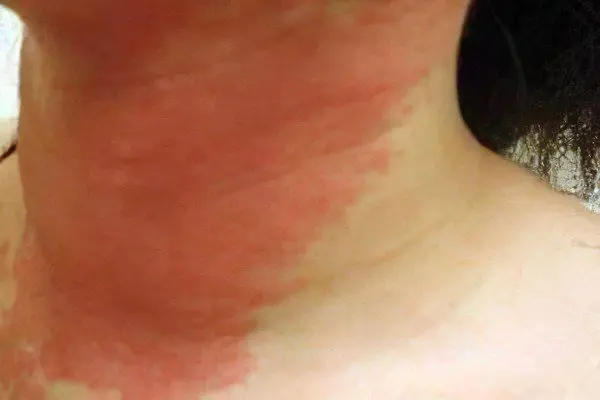
Red dermatitis
Red dermatitis is a chronic skin disease characterized by severe itching and monomorphic nodular rashes – papules. The color of papules is pink-red with a purple tint. An important diagnostic sign is an indentation at the top of the papules. Growing papules expand along the periphery and merge into plaques 8-10 cm in size. The plaques acquire a gray-red color and thicken. In the recovery stage, areas of brown hyperpigmentation remain in place of the plaques.
Typical localization of red dermatitis:
Flexion (inner) surface of the joints of the hands;
Lateral surface of the body;
The mucous membrane of the mouth and genitals.
Food dermatitis (food allergy)
It is diagnosed starting from the first days of life. The disease is characterized by a chronic course, in advanced cases it is incurable. The influence of food allergies on the development of asthma in children and adults has been proven.
Children
Food dermatitis in children begins very early. The first skin symptoms in newborns with hypersensitivity to certain foods appear as:
Redness on the cheeks and buttocks;
Seborrheic scales on the head;
Diaper rash.
Correct diagnosis of the causes of food intolerance will save the baby from many problems in the future. Before contacting an allergist, you should pay attention to the quality of life of the baby and the environment.
Possible factors that provoke food allergies in children can be:
Unfavorable ecological situation;
Genetic predisposition;
Frequent consumption of foods containing allergens.
In adults
Food dermatitis in adults looks a little different. Hypersensitivity manifests itself after eating in the form of:
Flatulence (increased gas formation) and a feeling of heaviness in the abdomen, heartburn, indigestion;
Skin itching without rash;
Runny nose, nasal congestion, allergic conjunctivitis;
Rapid fatigue, weakness and swelling of the limbs.
Rarely – an increase in body temperature.
Forms of dermatitis
Dermatitis can occur in acute and chronic form. Some medical specialists point to a subacute course. However, it is difficult to establish the boundaries of this form of the disease, the definition is based on the subjective feelings of the doctor.
Acute dermatitis
The onset of the acute form is characterized by sudden itching, slight fever, possibly rhinitis (inflammation of the nasal mucosa) – this is typical for allergic atopy. Symptoms inherent in the underlying disease and rashes consisting of a primary rash are signs of infectious dermatitis caused by viruses, fungi or bacteria. For acute forms of dermatitis, common symptoms of inflammation of moderate intensity are characteristic (limited redness, swelling, soreness, impaired function, increased local temperature). As for the morphology of the rash, in the acute phase there are papules, vesicles, less often – bullae.
Chronic dermatitis
In the chronic course of the disease, the symptoms of inflammation are erased. Secondary rashes are found on the body.
Based on the type of secondary rash, in some cases it is possible to predict the outcome of the disease:
Unfavorable outcome – atrophy;
Doubtful outcome – scabs, cracks, scales, abrasions, ulcers, erosion;
Completion of the pathology – healing without a trace, hyperpigmentation, dyschromia, depigmentation, lichenification, scar.
Dermatitis treatment
Due to the wide spread of dermatitis of various etiopathogenesis, scientists and physicians have developed schemes and methods for the treatment of skin diseases based on drugs and physiotherapeutic agents. There is no universal treatment for dermatitis. Therefore, all treatment regimens, the necessary medications and the duration of the course of treatment are determined by the doctor individually for each patient.
All modern methods of treating dermatitis are based on three principles:
The principle of a comprehensive diagnosis, which includes traditional and new methods of research of the skin and the body of the patient with the determination of the causes of the disease and the nature of pathogenesis;
The principle of multifactorial influence on the pathogenesis of the disease, including the neutralization of the pathogenetic effect of the agent, the impact on the symptoms of the disease in order to eliminate disturbing factors and adjust the body’s defenses (drug and psychotherapeutic);
The principle of continuity of treatment. Therapy of dermatitis correlates with the time required for complete regeneration (recovery) of skin tissues. It has been proven that the period of complete regeneration (cell renewal) of the skin is at least 28 days.
Diet and proper nutrition

With allergic dermatitis, a special diet and rational nutrition are part of the patient’s recovery system. Properly organized nutrition and hypoallergenic products in the patient’s diet are the key to the non-ingestion of new doses of allergens into the body. Before a visit to the doctor, you must independently determine the minimum list of products that can be consumed without the risk of exacerbating allergic reactions.
Clinical testing with allergen markers can speed up the process of formulating a safe diet. Without the use of markers, it is recommended to gradually include new products in the menu with an interval of two weeks. In order to make it easier for you to navigate the choice of products, we offer an approximate list with an average and high risk of provoking food allergies and dermatitis.
Product groups | Low allergenic products | Medium allergenic products | Foods that often cause allergies |
Protein: | Some types of fish (cod and sea bass), lean veal, offal (liver, tongue), low-fat cottage cheese, butter. | Lamb, horse, rabbit | Pork, fatty beef, milk, chicken egg, fish, seafood, caviar, smoked meats, delicacies, stew. |
Vegetable: | Cereals (rice, pearl barley), green lettuce, cucumbers, zucchini, swede, fresh cabbage, spinach, vegetable oil, pears, gooseberries, white cherries and white currants. | Rye, buckwheat, corn, green fruits, potatoes. | Legumes, sauerkraut, pickled vegetables, all red berries, all tropical fruits, mushrooms, dried fruits (dried apricots, raisins, dates, figs). |
Beverages: | Fermented milk without added dyes, compotes from pears and apples, decoctions of rhubarb, green tea of low concentration, non-carbonated mineral water. | Black tea, green apple juices, herbal decoctions. | Sweet carbonated water, filled yoghurts, cocoa, coffee. |
Dessert: | Dried fruits from dried pears and apples, prunes. | Yoghurts, mousses, curds. | Caramel, marmalade, chocolate, honey. |
Seasonings and sauces: | — | — | Ketchup, mayonnaise, soy sauce, canned soups, and any prepared foods containing colorants, emulsifiers, preservatives, and other food additives. |
With dermatitis without an allergic load, proper nutrition is more important. The main principle is the inclusion of low-calorie, easily digestible foods in the diet. There are no universal recommendations. You can learn more about the products recommended to you personally by your doctor and nutritionist.









